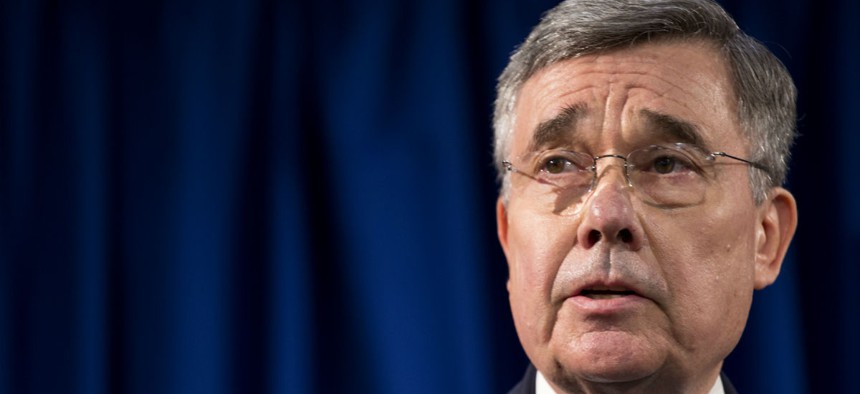
CBP Commissioner R. Gil Kerlikowske speaks during a news conference in October 2014 about whether agents and officers should be required to wear body cameras. AP file photo
Feds Will Soon Begin Limited Testing of Body Cameras
Border Patrol union oppose the technology; CBP wants more studies.
Despite pressure from immigration advocacy groups and even the White House for equipping law enforcement personnel with body cameras, Customs and Border Protection continues to have reservations about the technology. More than a year after CBP Commissioner R. Gil Kerlikowske ordered a review of the feasibility of requiring agency law enforcement officers to wear body cameras -- the first of its kind on the federal level -- CBP has concluded that it needs more time and further studies.
CBP announced Thursday it intends to create a “scaled deployment” of body-worn cameras, but they will only be used in training environments in the initial phase. Kerlikowske said his agency has not ruled out a much wider deployment of body cameras, including at the Border Patrol, but that process would not begin until CBP conducts further reviews and addresses various privacy concerns.
On a call with reporters Thursday, Kerlikowske stressed CBP is not “opposed to cameras.” The agency will roll out a plan to revamp and increase its use of cameras early next year. CBP currently uses nearly 9,000 cameras covering the borders and various checkpoints and facilities, though they are not affixed to individuals and many rely on outdated technology, Kerlikowske said.
The forthcoming report, due to the commissioner by the end of January, will assess the possibility of expanding body cameras to other environments. CBP officials said during the initial feasibility review the agency encountered problems with both technology and labor. The Border Patrol union, the National Border Patrol Council, has resisted the adoption of the cameras. Kerlikowske and the officials said they are negotiating with the labor group over how they could implement body camera usage in compliance with existing collective bargaining agreements.
“You cannot unilaterally impose a requirement without at least bargaining,” Kerlikowske said. Eventually, he added, he expects his workforce to come around as they realize the benefits cameras can provide. Already, he said, he has heard from employees who appreciate the technology’s ability to resolve frivolous complaints.
On the technology side, Kerlikowske said the cameras CBP has tested could not endure the conditions Border Patrol agents routinely experience, such as dust, brush and near constant deployment. He said dashboard cameras on CBP vehicles could provide an additional solution, and another forthcoming report will further evaluate that option.
While progress has been slow, CPB officials said they are looking at an expenditure of at least tens of millions of dollars, so the agency is advancing with care. Kerlikowske said he has already heard from other federal agencies, both uniform and non-uniform, that expressed interest in the reviews conducted by CBP. The pioneering nature of the work has added to the need to proceed with caution, he said.
As CBP seeks to expand and update its use of fixed and non-body, mobile cameras, Kerlikowske warned that the agencywide use of body cameras is unlikely.
“A full-scale deployment on every person is not necessary,” he said. Some checkpoints and facilities, he explained, are already “very camera rich” and additional body cameras would be “redundant.”
If CBP expands the testing of body cameras, as Kerlikowske pledged, officials said they would not necessarily be worn in areas where the agency receives a lot of complaints or negative attention. Instead, they would be deployed using a risk-based approach that analyzes existing capabilities and operational need.
Immigration advocates and groups like the American Civil Liberties Union have called for better oversight of CBP personnel after reports of excessive use of force. Thursday’s announcement exacerbated those groups' concerns.
“Today’s decision to not broadly implement body-worn cameras is a significant step backwards for CBP,” said Ben Johnson, executive director of the American Immigration Council. “For an agency that has significant problems with transparency and accountability, the excuses provided to not move forward in a bold and comprehensive way will only deepen that perception.”
He added that CBP, the largest law enforcement agency in the country, was “out of step” with agencies at the state and local level that have moved forward with body cameras. President Obama has supported using federal funds for body cameras at local police forces.







